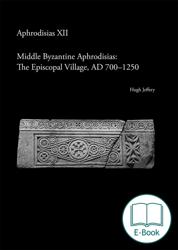This study addresses the settlement at Aphrodisias, known to its medieval inhabitants as Karia, from the eighth through thirteenth centuries. Important bodies of archaeological data, including numismatics, funerary archaeology and liturgical sculpture are presented for the first time. The volume offers a holistic view onto a post-urban settlement functioning as a provincial outpost of the Byzantine Church, and demonstrates how the archaeology of ancient cities is mediated by medieval occupation, construction and curation.
Aphrodisias is one of the best-known archaeological sites in modern Turkey. The Aphrodisias Excavations Project has been ongoing since 1961, and in 2017 the site was inscribed on the UNESCO World Heritage List. The settlement flourished as a monumental city from the first through the sixth centuries AD.
This monograph addresses the archaeology of the settlement from the eighth through to the thirteenth century. It collates and integrates material already published and presents important new bodies of archaeological evidence, providing a holistic view onto a Middle Byzantine episcopal village.
After a historiographical introduction, the second chapter presents a topographic gazetteer of Middle Byzantine activity at Aphrodisias. The third chapter addresses the monetary economy of the Morsynos Valley, offering an interpretation of a large numismatic catalogue.
The fourth chapter analyses a corpus of over two hundred items of liturgical sculpture, tracing medieval interventions in the settlement’s ecclesiastical architecture. The fifth chapter presents the medieval intramural cemeteries, before discussing the potential of funerary archaeology to contribute to the social history of the settlement. The sixth and final chapter compares the medieval settlement at Aphrodisias with those at Amorion, Miletos, Ephesos and Hierapolis before commenting on the historical development of the ruralised settlement pattern the Middle Byzantine Maeander.
The past decade has witnessed a burst of archaeological research into the archaeology of Middle Byzantine Asia Minor, testifying to the vibrancy of a subject that until recently had been marginal to the agenda of Classical Archaeology in Turkey. The volume will be of interest to scholars of Byzantine history, economy and society. But it is also written so as to be accessible to those who have less experience of Byzantine Studies. The monograph contributes to the study of one of the most significant sites of the Roman Mediterranean, and shows how the archaeology of such sites is inevitably mediated through medieval curation, occupation and construction.
Hugh G. Jeffery
Born London, 13/10/1992.
Employment
2020-2021 Postdoctoral Researcher – History, University of Oxford
2019-2020 Career Development Fellow – Classics, University of Edinburgh
2018-2019 Predoctoral Fellow, Koç University Research Center for Anatolian Civilizations (Istanbul)
Education
2015-2019 DPhil Classical Archaeology, University of Oxford
2014-2015 MSt Classical Archaeology, University of Oxford (Distinction)
2011-2014 BA Classical Archaeology and Ancient History, University of Oxford (1st Class)
The series is dedicated to the publication of archaeological research at the ancient site of Aphrodisias. Aphrodisias was a prosperous city of the Roman period, well known for its cult of Aphrodite and its marble-carvers, and it has remarkably preserved remains from the second century BC to the sixth century AD. The archaeology of the city is especially well-suited to the study of public art and monuments in their ancient contexts and to the investigation of the elaborate architectural mise-en-scène of urban political life in the Eastern Roman empire.


 Inhalt
Inhalt